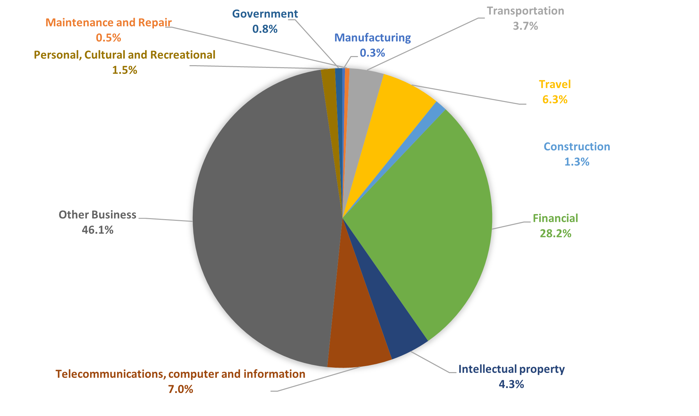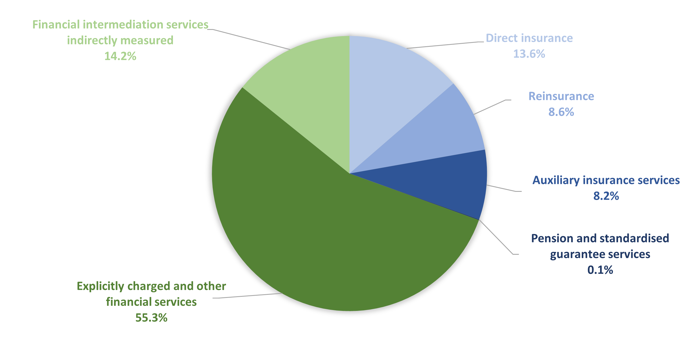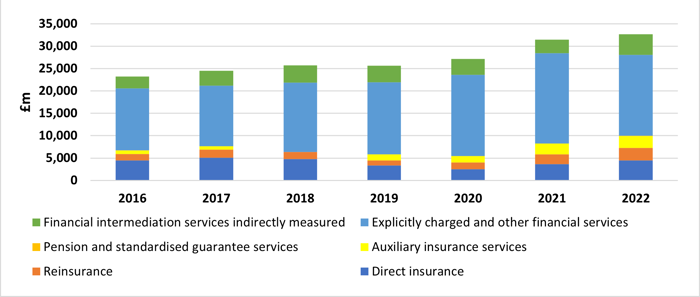A closer look at financial services trade between the world’s two largest financial services exporters: the US and the UK
In my last blog post, I examined trends over time in the financial services trade surpluses of the UK and the US. I noted that these two countries are not only the world’s largest net exporters of financial services by a wide margin, but also each other’s largest financial services trade partner. According to data from the Office for National Statistics (ONS), in 2022 (latest available annual data) the US accounted for 34% of UK financial services exports and 33% of financial services imports. According to data from the US Bureau of Economic Statistics, the UK accounts for 14% of US financial services exports and 20% of US financial services imports.
ONS data show that the UK’s total services exports to the US were £116bn in 2022, and that financial services accounted for 28% of this. That made it the second-largest services export sub-sector—behind only ‘Other business services’, which includes the professional services related to financial services, among other things.
UK services sector exports to the US, % of total services exports to the US, 2022 Source: TheCityUK calculations based on Office for National Statistics data
Source: TheCityUK calculations based on Office for National Statistics data
Looking in more detail at the £33bn of UK financial services exports to the US in 2022, the ONS data show that insurance and pension exports account for almost one-third of financial services exports. The bulk of sector exports are split between explicitly and implicitly charged financial services.[1]
UK financial services sub-sector exports to the US, % of total financial services exports, 2022
Source: TheCityUK calculations based on Office for National Statistics data
These proportions have remained relatively stable over the past seven years, highlighting the extent to which trade patterns tend to be relatively slow to change. Since 2016, there have been some small changes in the composition of insurance exports from the UK to the US, with direct insurance exports declining slightly but reinsurance and auxiliary insurance exports increasing slightly. Overall, though, sector exports to the US have remained dominated by ‘explicitly charged and other financial services’ (around 60% of UK financial services exports to the US over the period) and direct insurance exports (around 15%).
UK financial services sub-sector exports to the US, 2016-22 Source: Office for National Statistics.
Source: Office for National Statistics.
In my last post, I also touched on the issue of balance of payments asymmetries—in this case, the fact that US imports of UK financial services (as reported by the US) differ significantly from UK exports of financial services to the US (as reported by the UK), when in theory those two figures should be the same. In fact, in 2022, UK financial services exports to the US as reported by the ONS (£32.7bn) were almost double the US financial services imports from the UK reported by US Bureau of Economic Analysis (BEA) (£19.1bn, converted from US dollars at the average exchange rate for 2022). The possible reasons for such a discrepancy were highlighted in my previous post. Discrepancies can also be seen in the more detailed, sub-sector data. For example, the US data accord higher weight to reinsurance than the UK data do: BEA data put reinsurance imports from the UK at around 15% of financial services imports from the UK, versus the 6% (average) figure from the ONS. The US data put correspondingly less weight on direct insurance trade, with BEA data showing direct insurance imports from the UK at around 10% of financial services imports from the UK (versus the 15% share recorded by the ONS).
Nevertheless, despite the discrepancies, the US and the UK data do tell broadly the same story about the composition of financial services trade. Like the ONS, the BEA records ‘explicitly charged and other financial services’ imports from the UK as being the largest component by far of overall financial services imports from the UK, at around 63%. Given the importance of the UK-US financial services trade relationship, it is worth examining the data to understand the relationship in as much detail as possible.


